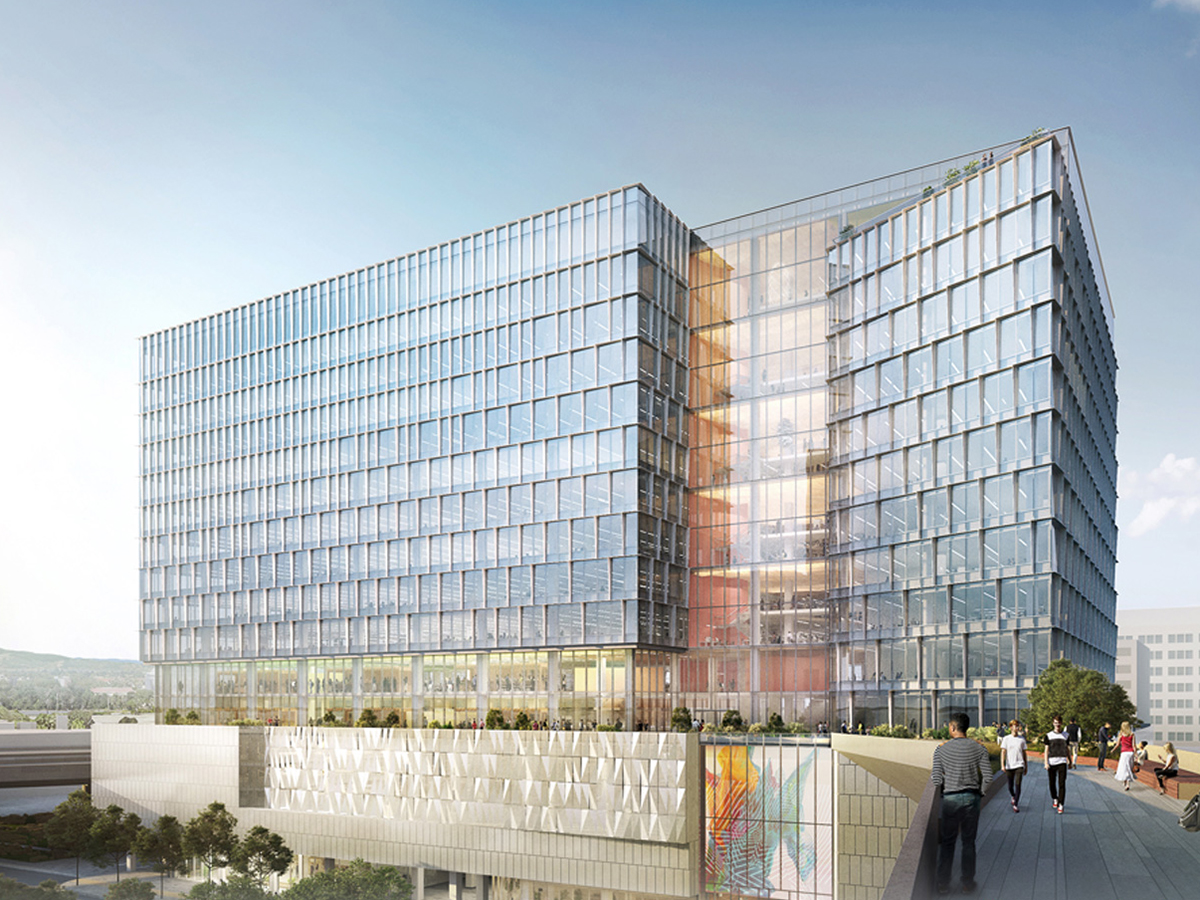Electrification: More Buildings Plug Into the Grid
The push to electrify commercial buildings is gaining traction nationwide, but don’t expect most landlords to abandon their boilers anytime soon.

Kilroy’s On Vine in Hollywood, Calif., was designed to function without natural gas in its core or shell. Photo courtesy of Kilroy Realty Corp.
As governments around the world battle to reduce carbon emissions, a growing number of cities and states across the U.S. are exploring measures to support the electrification of buildings. These initiatives vary widely in their nature and scope, but what they have in common is a drive to encourage—or in some cases, require—building owners and managers to ditch traditional fossil fuel-based systems in favor of all-electric sources of heat and hot water.
Buildings figure prominently in the campaign against carbon due to their copious production of greenhouse gases, accounting for roughly two-thirds of total carbon emissions in cities such as New York, Boston and Minneapolis. Analysis by smart building platform Bractlet indicates that more than 1.8 million commercial buildings in the U.S., or 43.3 percent of the total, use electricity as their primary heating source, compared to 2.3 million buildings—55.3 percent of the total—that use natural gas. The analysis is based on data provided by the U.S. Energy Information Administration’s Commercial Building Energy Consumption Survey.
Electrification involves phasing out and replacing oil- and gas-fired systems, such as boilers and furnaces, with technologies such as air-source heat pumps and heat pump water heaters, which use electricity to provide higher efficiency. Assuming the power grid can be “decarbonized,” converting buildings to electric energy could play a key role in curbing a city’s emissions.
Galvanizing change
The U.S. is taking small steps toward a more electrified future, and the West Coast is leading the way. In a historic first, the city of Berkeley, Calif., passed an ordinance in July that bans the installation of gas hook-ups in new houses, apartments and commercial buildings, beginning January 1, 2020. Several California cities have followed suit, with Windsor, San Mateo, Carlsbad and San Luis Obispo recently advancing “reach codes”—ordinances that are stricter than the state’s existing regulations—to support the electrification of new buildings.
The Bay Area city of San Mateo, for example, adopted an electric-preferred code in August that incentivizes all-electric new construction. The trend has spread beyond California, with Seattle recently introducing legislation to phase gas out of new construction.
That said, it isn’t clear that many landlords across the U.S. will be forced to abandon fossil fuels anytime soon. “Currently there are very few laws that would really powerfully drive building owners towards electrification of existing buildings,” said Cliff Majersik, executive director of the Institute for Market Transformation (IMT). The pioneering law in Berkeley only applies to new buildings, he noted.
In New York City, electrification is being discussed as a possible outcome of the Climate Mobilization Act, an aggressive policy signed into law in April, which compels large and medium-sized buildings to slash greenhouse gas emissions by 40 percent by 2030 and 80 percent by 2050. But landlords may not see much advantage in scrapping their boilers and furnaces, due to the city’s high carbon content of electricity.
“The law is based on carbon,” said Majersik. “And as it stands now, there’s not too much incentive to electrify because their electricity is not particularly clean in New York. You can get some benefit if you’re putting in some very high-efficiency heat pumps, that sort of thing. But it’s not a massive push towards electrification currently.”
Learning to love electric
Comprehensive policy change may still be a distant prospect, but some of the more ambitious developers and corporate occupiers are going all-electric without a nudge from regulators. Kilroy Realty Corp. has emerged as a pioneer in this space, with more than 2.2 million square feet, or 17 percent of its total real estate portfolio, now entirely all-electric.

Marina-City, Chicago, which features all-electric heating, cooling and hot water with indiviudal room control. Image courtesy of Mack Male via Wikimedia Commons
“It is our goal to reduce the carbon emissions of our portfolio as much as possible, and we believe that all-electric buildings are an important part of achieving that goal,” noted Sara Neff, senior vice president of sustainability at Kilroy.
The listed real estate investment trust is currently developing two all-electric projects in California: 2100 Kettner, a 174,380-square-foot office property in San Diego, and On Vine, a 600,000-square-foot mixed-use development in Hollywood, both of which feature no natural gas in their core and shell designs. On Vine, which sits on a full city block at the corner of Vine Street and Sunset Boulevard, will deliver three creative office buildings along with a 20-story residential tower. Last November, Netflix preleased all 355,000 square feet of available office space in the development, which will begin delivery in mid-2020.
There is no cost premium for developing a building without natural gas service if the all-electric design is incorporated from the beginning, Neff said. However, all-electric buildings often require more square footage for mechanical equipment, which could limit available roof space for solar.
“The significant challenge is that the building code energy modeling compliance software was developed without the idea of an all-electric building in mind and depending on the design can punish a building for going all electric,” Neff added. “There are a lot of folks working on fixing this problem, but it isn’t currently resolved.”
Another leader in the electrification drive is software maker Adobe, which broke ground in June on the fourth tower of its global headquarters in downtown San Jose, Calif. The 18-story, 700,000-square-foot Adobe North Tower, which is being developed by Sares Regis Group, will run fully on electric power. Slated for completion in 2020, the project housing up to 4,000 employees will be one of the first all-electric buildings in Silicon Valley, helping Adobe meet its target of powering its operations with 100 percent renewable energy by 2035.

Adobe North Tower in downtown San Jose, Calif., will derive its power from renewable sources like wind and solar energy. Rendering courtesy of Adobe
Doing what makes sense
Despite the growing interest in plugging buildings into the power grid, electrification is just one component of sustainability and may not make sense for everyone. For many landlords, electrifying an existing building comes with a hefty price tag; according to Bractlet estimates, the cost of replacing two boilers to upgrade a 100,000-square-foot building to electric heating hovers around $50,000 to $80,000, depending on climate. The expense may not even be worth it, given the various other options that are available to make a property more energy-efficient, such as overhauling lighting, replacing equipment, and upgrading walls and windows.
“If you don’t have a system already, building all-electric for new construction can be accomplished often at little or no additional cost,” said Majersik. He noted that apartment buildings now routinely deploy heat pumps in each unit.
“It’s much more of a challenge if you have a large building with a large furnace or boiler heating the whole building,” he added. “Then there’s not a lot of precedent for that kind of a building converting to all-electric heat pumps.”
Furthermore, pushing for electrification may be one of the least effective ways of cutting emissions until the power grid is decarbonized, an effort that could take decades and cost several trillions of dollars nationwide.
“You have to be pragmatic,” said Alec Manfre, CEO & co-founder of Bractlet. “If we’re trying to get our owners to spend $200,000 on our building, how do we prioritize that capital in a way that maximizes emissions reductions but also gives them returns so it’s also win-win for them?”







You must be logged in to post a comment.